37 F. average high on March 7.
31 F. high on March 7, 2013.
16" snow on the ground at KMSP.
40s likely by Sunday and Monday.
No major storms (of any flavor) in sight.

Don't Forget.
Set your clocks ahead one hour late tonight as we welcome DST, Daylight
Saving Time, with open arms. Another sign of lukewarm days to come.
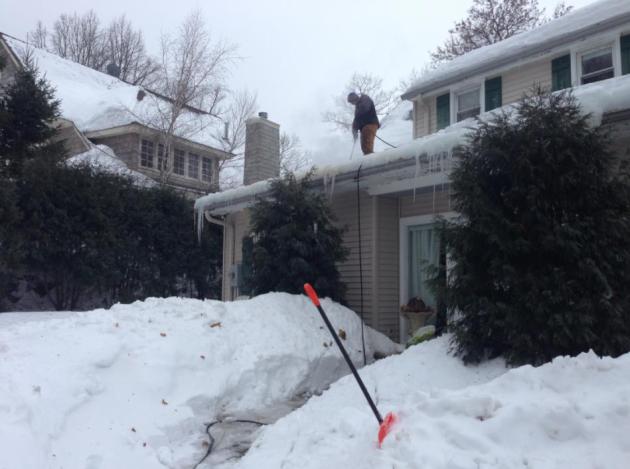
Dirty Snow Season
“Unusual travel suggestions are dancing lessons from God” wrote Kurt Vonnegut. How true. The world has done a pretty good job convincing us that stuff matters. But in the end all we have are memories. As my late mother told me "at the end of your life what matters is what you've seen, who you've loved and who you helped."
Our lousy, endless winter probably contributed to my newfound wanderlust, and one-too-many trips to warmer destinations, but my wife and I were always relieved to return to MSP. Because you doesn’t fully appreciate Minnesota until you leave, and then return home.
The DNR reports that, statewide, meteorological winter was the 4th coldest in 119 years of record-keeping. Nationwide early March saw the most snow on the ground since 1978. We've earned our spring this year.
Models show 40s Sunday & Monday, again late next week. Milder, Pacific air passing over cold snowpack will moisten up the low layers of the atmosphere, sparking low stratus and fog at times.
Expect a slush-fest next week.
Time to dig out the second-string shoes.
I just had serious ice dams removed from my roof, so I'm praying for a slow thaw and no tournament snowstorms. But after this winter-on-steroids, I'm not feeling very lucky.


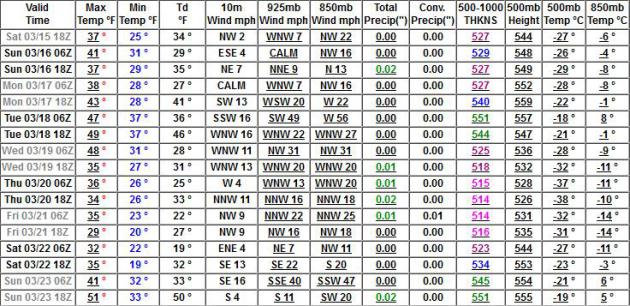
Relieved To Be Average Again.
GFS numbers confirm a slow moderating trend, daytime highs in the 30s
and 40s the third week of November with no sign of a Tournament storm -
at least not yet.
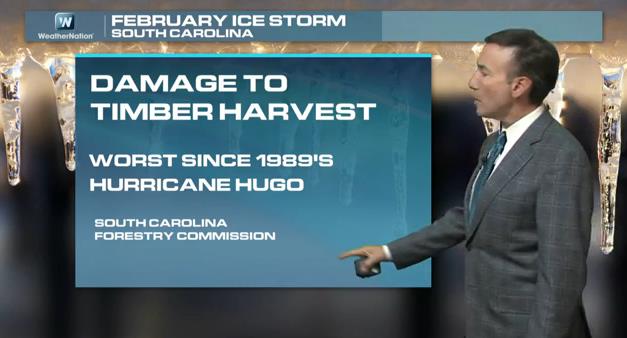
Super-Sized Winter of 2014: Ice More Damaging Than Snow.
Snow gets much of the national media attention, but ice is far more
dangerous and damaging, sparking more accidents, roof collapses and
downed tree limbs and power lines. That's the subject of today's edition
of Climate Matters: "Yes,
this has been a jaw-dropping, super-sized, winter on steroids winter
east of the Rockies." -- Meteorologist Paul Douglas said. A crazy winter
it has been for much of the U.S. as snow, ice and freezing rain
continues into March. The Great Lakes are breaking ice-cover records and
snow covered 54% of the U.S. as of Tuesday, the most since 1978. It has
been a wild one."

Snow Water Equivalent.
The latest numbers from NOAA estimate 3-4" of liquid water trapped in
the snow pack over the south metro, but closer to 5-6" from Isanti and
Cambridge to Taylors Falls, as much as 10" along Lake Superior's North
Shore. Pray for a gradual thaw (with no heavy rain).
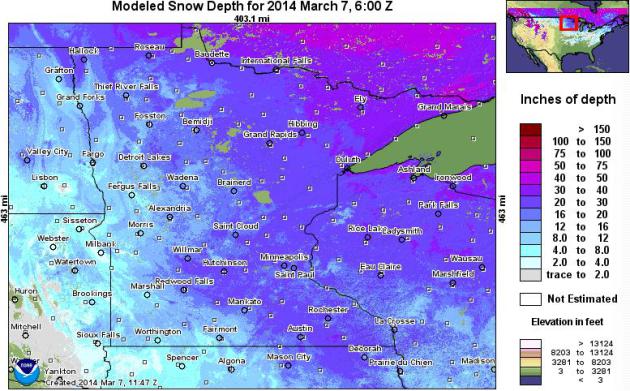
Unusually Deep Snow Over Northeastern Minnesota.
In his most recent post, Dr. Mark Seeley answers a listener question
about the deep snow pack along the North Shore and over the Minnesota
Arrowhead. Here's an excerpt of his response at Minnesota WeatherTalk: "...Though
not record-setting it is rare to have snow depths over 40 inches, yet
several observers have reported these amounts for this winter including
47 inches near Two Harbors, 43 inches at Isabella, 42 inches at Wolf
Ridge and Babbitt, 41 inches at Cook, and 40 inches at Cloquet and Grand
Marais. The measurement of 47 inches neat Two Harbors is the deepest
snow there since they measured 51 inches in March of 1965. Similarly at
Babbitt the reading of 42 inches is the most there since a snow depth of
52 inches in February of 1969. The state record by the way is a snow
depth of 75 inches at Pigeon River Bridge in March of 1950..."
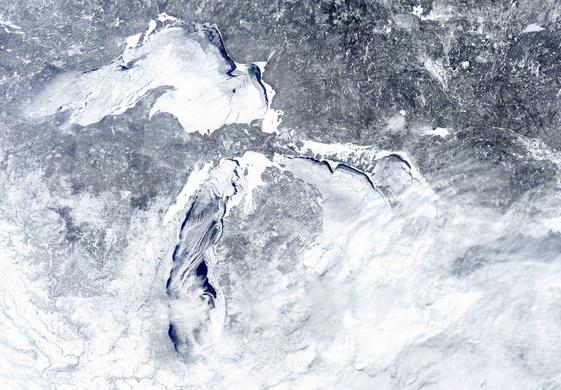
Snow, Ice Cover Will Boost Great Lakes Ice Levels. AP has the article - here's a link and excerpt: "Water
levels in the Great Lakes are expected to continue a steady recovery
this year, courtesy of widespread ice cover that is slowing evaporation
and snowfall that has approached record amounts in some cities, federal
experts said Wednesday. The siege of polar air that has gripped the
region this winter has caused the most extensive freeze-over of the
lakes since the record-setting year of 1979, when nearly 95 percent of
their surface area solidified. On Tuesday, the ice cover reached its
highest point since then - 91 percent, said George Leshkevich, a
physical scientist with the federal Great Lakes Environmental Research
Laboratory in Ann Arbor..."
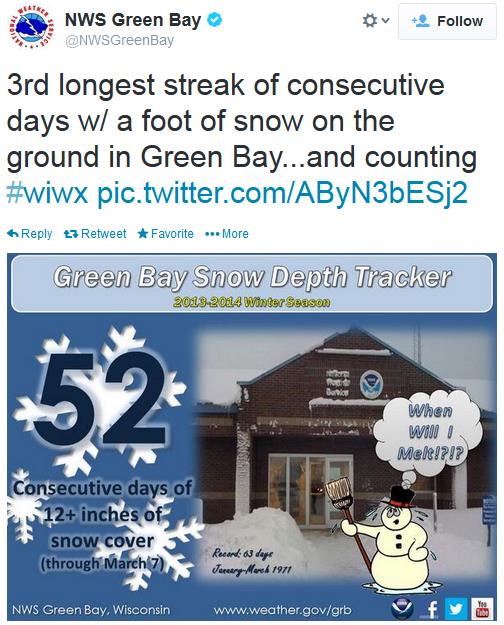
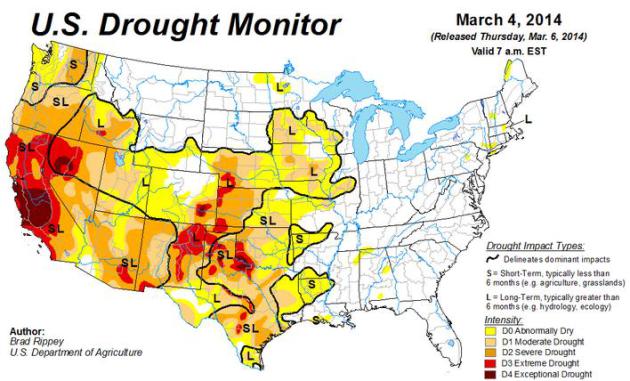
Trapped In A Devastating Drought, California Needs To Take On Some Surprising Sacred Cows. Here's a clip from a story at New Republic which puts the the drought into stark perspective: "...Today
in California, a different kind of resource shock is unfolding, and it
too may end up, a generation hence, defining an era. This time the
resource is water, not oil. Today’s California drought is starting to
force similarly life-changing choices, this time in the nation’s most
populous state, long a bellwether and, according to some counts,
the world’s eighth largest economy. The land of milk and honey has
begun in recent weeks to get serious about its water crisis: Farmers are
ripping out crops, religious believers are praying for rain, and local
governments are ordering restaurants to stop serving glasses of water
except to diners who specifically request them. This comes at a time
when America’s domestic supply of the natural resource it has cared most
about—fossil fuel—is more plentiful than ever..."
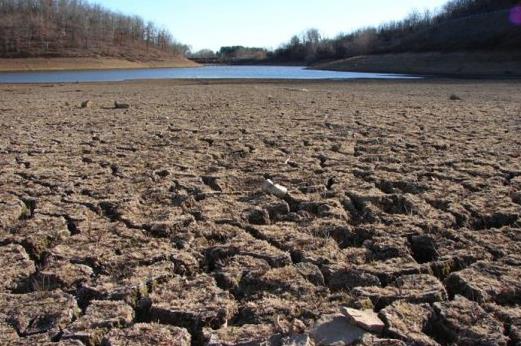
- In a warming world, a larger fraction of total precipitation falls in downpours, which means a larger fraction is lost to storm runoff (as opposed to being absorbed in soil).
- In mountain regions that are warming, as most are, a larger fraction of precipitation falls as rain rather than as snow, which means lower stream flows in spring and summer.
- What snowpack there is melts earlier in a warming world, further reducing flows later in the year.
- Where temperatures are higher, losses of water from soil and reservoirs due to evaporation are likewise higher than they would otherwise be..."
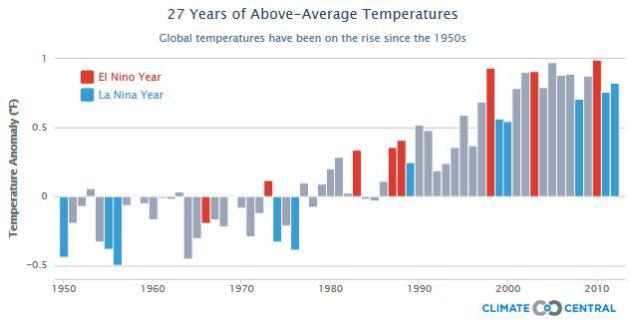
Get Ready For The Next Climate Phenomenon: El Nino.
As we told you yesterday the probabilities of lurching into an El Nino
warming phase of the Pacific are increasing for later in 2014. The
implications for Minnesota and the rest of the nation? Here's an excerpt
from Climate Central: "...An
El Niño increases the likelihood of wet conditions in California and
the Southwest, which could provide relief to areas suffering through severe drought. Warm conditions are also more likely in the Northeast. That’s welcome news for a region where teeth have been chattering
all winter. The Eastern Seaboard could also see the major hurricane
drought stretch for another year as El Niño tends to inhibit the
formation of Atlantic Hurricanes. The last official major hurricane to
make landfall in the U.S. was Hurricane Wilma in 2005..."
Image credit above: "Global average surface temperatures, showing El Niño years in red." Credit: Climate Central using WMO data.

Bow Echo.
Here's a good summary of the bow echo - straight-line wind event that
swept across south Florida Thursday, producing 60-65 mph. wind gusts,
courtesy of NOAA SPC meteorologist Greg Carbin and the Miami National Weather Service.

Shelf Cloud.
WeatherNation TV meteorologist Bryan Karrick snapped this photo of a
thunderstorm gust front and resulting shelf cloud at Isla Mujeres, just
off the coast of Cancun, Mexico. Not a bad selection at all for Spring
Break.
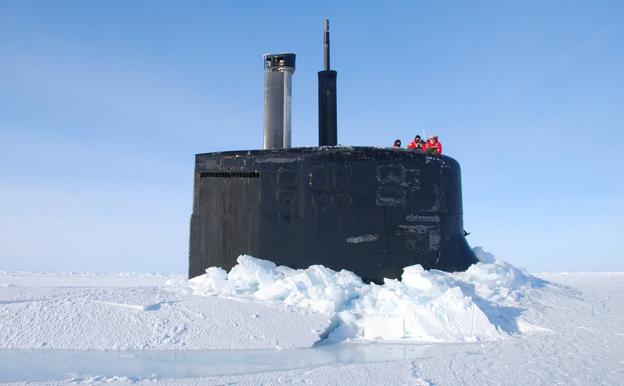
Don't Worry. WWIII Will Almost Certainly Never Happen.
The old axiom that nations that trade together rarely go to war
together may have some merit - but complacency is never a good idea
either. The Week has the story - here's a clip: "...But what about a non-nuclear global war? Other changes — economic and social in nature — have made that highly unlikely too.
The world has become much more economically interconnected since the
last global war. Economic cooperation treaties and free trade agreements
have intertwined the economies of countries around the world. This has
meant there has been a huge rise in the volume of global trade since World War II, and especially since the 1980s..."
File Image credit above: AP Photo/U.S. Navy, Cmdr. Christy Hagen.

Facebook Looks To Buy Solar-Powered Drone Company To Deliver Worldwide Internet.
Because I can't get FB in nearly enough places. I want to be able to
update my profile while steaming off the coast of Nigeria. Gizmag has the story; here's the intro: "Titan Aerospace's Solara,
a solar-powered unmanned aerial vehicle designed to cruise at an
altitude of 20 km (12.42 miles) for five years at a time, certainly got
our attention back in August, and it appears to have not gone unnoticed
by some of tech's bigger players either. Facebook is reportedly in talks
to acquire the company with a view to using the drones as a means of
providing internet access to the world's under-served regions..."

SAT Scores Of The Rich And Famous. I'm not surprised about Bill Gates, but Ke$ha scoring a 1500? Impressive. The New York Times has the blurb - here's an excerpt: "...The
cover story of this weekend’s magazine has the background of the SAT
overhaul. You can get an early look at it online Thursday morning. Until
then, here are the SAT scores that go with some boldfaced names, as
reported in places other than Twitter.
1. Ben Affleck: “Ben had almost perfect SAT scores in high school.”
2. Ke$ha: 1,500
3. Bill Gates: 1,590
4. George W. Bush: 1,206
5. Al Gore: 1,355
6. Scarlett Johansson: 1,080
2. Ke$ha: 1,500
3. Bill Gates: 1,590
4. George W. Bush: 1,206
5. Al Gore: 1,355
6. Scarlett Johansson: 1,080
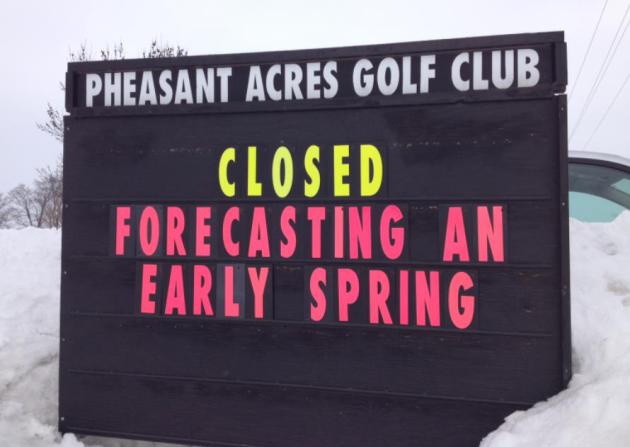
I Hope You're Right. The power of positive thinking, right?

TODAY: Sunny, cool breeze. Winds: NW 5-10. High: 25
SATURDAY NIGHT: Clear to partly cloudy and chilly. Turn your clocks ahead late. Low: 14
SUNDAY: Partly sunny, feels like March! High: 41
MONDAY: Some sun - hint of April. Outdoor lunch? Wake-up: 33. High: 44 (falling during the afternoon)
TUESDAY: Chance of snow southern MN. Sunshine central and north. Wake-up: 31. High: 37
WEDNESDAY: Intervals of sun, a quiet day. Wake-up: 16. High: 33
THURSDAY: Some sun, milder breeze. Wake-up: 19. High: 41
FRIDAY: Patchy clouds & fog. Not bad at all. Wake-up: 30. High: 42
Climate Stories....



No comments:
Post a Comment